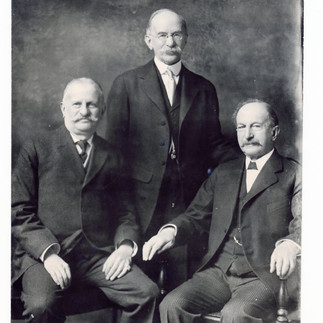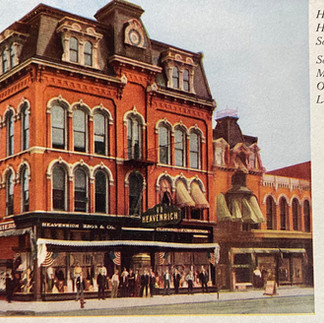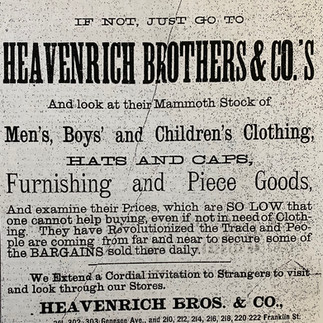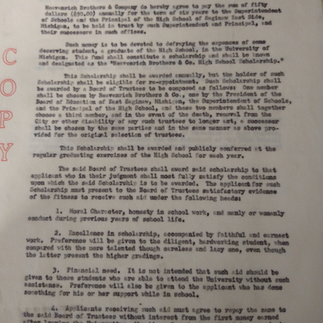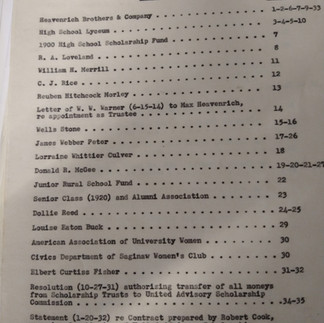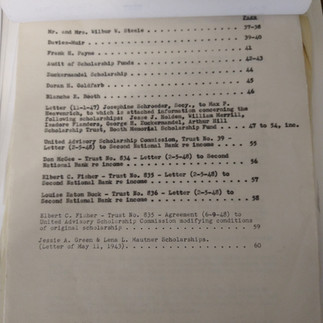
Every November the Saginaw Community Foundation begins accepting applications for scholarships so that the community’s graduates can seek continuing education. With one application, the students apply for hundreds of scholarships through the Foundation.
From left to right: Sam, Max and Carl Heavenrich. Heavenrich store front; advertisement is from May 6, 1882.
The scholarship program has a long history stretching back to 1891, when the first “Agreement for High School Scholarship” was made by Heavenrich Bros. & Co., a Saginaw mercantile and clothier. Heavenrich Bros. & Co. agreed to give $50 annually for six years to be held in trust to fund scholarships for East Saginaw students to attend University of Michigan. The agreement noted, “Such money is to be devoted to defraying the expense of some deserving student…” who would be announced at the graduation ceremony.
The selection criteria was as follows:
Moral character
Excellence in scholarship accompanied by faithful and earnest work
Financial need
Agreement to repay - no interest - after leaving university and starting a first job, not to exceed six years.
Although considered a scholarship at the time, in today’s parlance these were no interest loans. The idea was that with proper investment of the scholarship fund and repayment by graduates, the scholarship fund would be self-perpetuating. Each student who received aid would be helping the next generation of recipients by repaying.
The program was arranged through the school district, and it was administered by its own Board of Trustees made up of five people: one representative chosen by Heavenrich Bros., one chosen by the president of the East Saginaw School Board, the superintendent, the principal of Saginaw High School, and one other person appointed by the superintendent and principal.
Document files left to right: first agreement for scholarship 1891; listing of scholarships
Soon others started scholarships for East Saginaw graduates. The R. A. Loveland Scholarship began in 1901 and patterned itself after the Heavenrich Scholarship. The Board of Trustees’ responsibilities grew as it took on management of each new scholarship. The Loveland Scholarship used a similar criteria, and Helen C. Loveland gave $200 to start the fund.
Other scholarships had more specifications, like the scholarship fund bequeathed by William H. Merrill in 1907. The fund started with $3,000, and gave the Board directions to administer an annual loan not to exceed $250 for continuing education at the University of Michigan or the Michigan College of the Mines at Houghton. Criteria for the selected student included: good physical health; good moral character; industrious study habits; and recommendation of the superintendent and principal. Interestingly, this scholarship stipulated that the first awardee should be a young man but thereafter could be awarded to a woman. It also stipulated that if the east and west side school districts ever combined (which, of course, we know they eventually did), then the scholarship could be awarded to a west-side student. Merrill stated that his goal was to help those who wanted to work toward helping themselves, and he wanted to instill the idea of paying back the community in order to help others.
Each scholarship added over the decades built on the framework of the original Heavenrich Scholarship. Sometimes specific criteria were provided but most often the parameters simply followed what others had done. By the 1920s, there was greater diversification in the criteria such as a new Rural Scholarship, an art scholarship, and the Dollie Reed Memorial Scholarship specifying that the recipient did not need to be the best student but should have leadership qualities.
By the end of the 1920s, the board realized that conditions had changed, and each separate loan, administered individually might not be in the best interest of the community. In a 1927 letter from the Heavenrich Bros. & Co. to the Trustees, Heavenrich stated a desire to honor the original intent of the scholarship but felt to do so, it was necessary to “nullify the original terms and allow for combination with other funds.” In 1931, the trustees noted that there had been such a proliferation of scholarships that it had become difficult to manage. The trustees said it was time to centralize the control and management of the scholarships and alongside the Board of Education, created the United Scholarship Commission.
In 1948, the Fischer Scholarship transitioned from a loan to an outright gift. Margaret Fischer authorized Max Heavenrich to alter the agreement so that a worthy engineering student would receive the scholarship as a gift. A few years later, a letter from Mary Grace Ruppel noted the shift in expectation of a scholarship as a gift instead of a loan came because of the G.I. Bill following WWII.
In 2000, the Saginaw Community Foundation took over management of the scholarships from the United Scholarship Commission, and still continues the legacy of providing scholarships for students, which in turn helps the community as a whole when those recipients give back to their community in many different ways - certainly through the skills they gain through their continuing education.
During the open application period of November through mid-February, we will continue to share periodic posts about the fascinating history of scholarships in Saginaw.


